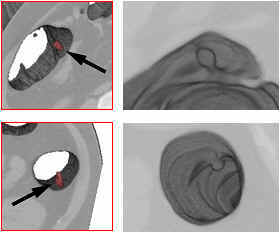
Algorithm- A
well-defined set of rules for performing a particular mathematical
calculation.
Benign- Of no danger to health,
not progressive or recurrent.
Byte- Unit of
information or memory size equal to eight bits; memory size is normally
measured in kilobytes (1024 bytes) or megabytes.
Chromosomes - Strands of DNA with genes located on
the chromosomes. These genes control the structures that inform
the cell on how to make certain proteins. Genes control the
number of fingers we have, the colour of our hair, eyes and lots
more. Each human has 46 chromosomes in each nucleus. (excluding sex cells)
Colour- the general name for all sensations arising from the activity of the retina of the eye and its associated nervous system. Colours vary in three different ways: hue, saturation and intensity.
Computed Tomography (CT) -
radiography in which a 3D image of a body structure is constructed by
computer from a series of plane cross sectional images along an axis.
Depth of field- The range of object distances over which a camera gives a sufficiently sharp image.
Depth of focus- The range of image distances over which the image remains sharp for a given object distance.
Edge detection
operator- An image-processing operator whose
effect is to highlight the
edges of an image
Engineer - person who uses scientific knowledge to solve problems
Geometric transform- Type
of image processing operator in which the transformed image is
essentially
recognisable but is in some way rotated, distorted or warped.
Grey scale- A numerical representation of intensity in which black is usually represented by 0, white by some fixed maximum number (e.g. 255) and shades of grey by intermediate numbers.
Image analysis- concerned with the extraction of explicit information regarding the contents of the image.
Image processing- The principal objective of image processing is to process a given image, so that it is more suitable for a specific application. The term is also used in a generic sense, to include Image Analysis and Image Enhancement.
Machine vision- The use
of devices for optical, non-contact sensing to automatically receive
and interpret
an image of a real scene in order to obtain information and/or control
machines
or processes
Malignant- Can be dangerous to
health. Is progressive and can reoccur.
Nuclei- plural of nucleus.
Nucleus - is the control centre of the cell. It consists of DNA strands. This DNA is arranged into structures called chromosomes.Pixel (Pel)- Picture element; the smallest addressable section of a digital image. Within the pixel boundaries the grey level or colour of the image can be considered constant.
Polyps - usually benign growth
or tumour protruding from the mucous lining of an organ sometimes
causing an obstruction.

Segmentation- a process that divides an image into its constituent parts or objects. It is a grouping process which identifies regions in the image as being similar, with respect to some defined criterion..
Radiation - emission and propagation of energy in the form of rays or waves. Stream electromagnetic waves emitted by the atoms and molecules of a radioactive substance as a result of nuclear decayRadiologist - physician specialising in the use of radiation for the scientific examination for diagnostic and therapeutic purposes. (
Tomography - method of producing a 3D image of the
internal structures of a solid object (human body)
Virtual
Colonography-
takes hundreds of images of the
abdomen which computer software rebuilds allowing radiologists to take
a virtual 3 dimensional (3-D) tour of the colon.
